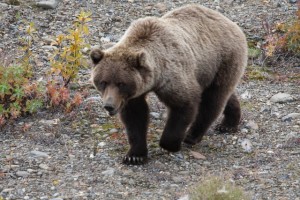Bear Tragedy and Bear Triumphs
 The shooting of a grizzly bear by a hiker in Denali this May was a terrible tragedy that stands in sharp contrast to the National Park Service’s remarkable success in managing bear-human conflict at Denali over the past 25-30 years. The Denali Citizens Council would like to take this sad opportunity to review the other side of the story, untold in news media, about this success story. (For more details of the bear shooting, see separate article on DCC’s June 29 forum on the federal and state governments’ respective takes on wildlife management issues.)
The shooting of a grizzly bear by a hiker in Denali this May was a terrible tragedy that stands in sharp contrast to the National Park Service’s remarkable success in managing bear-human conflict at Denali over the past 25-30 years. The Denali Citizens Council would like to take this sad opportunity to review the other side of the story, untold in news media, about this success story. (For more details of the bear shooting, see separate article on DCC’s June 29 forum on the federal and state governments’ respective takes on wildlife management issues.)
As visitation to Denali began growing in the 1970s, so did problems with bears. By the early 1980s, the number of reported incidents since 1949 in which a bear encounter resulted in an injury to a park visitor or employee had risen to nearly a dozen, including 3 incidents in 1980 alone. The National Park Service, aware of the long-term bear problems in parks such as Yosemite and Yellowstone, took an aggressive and pro-active stance to prevent bears from becoming conditioned to human food and to educate park visitors how to behave in ways that would avoid triggering aggressive bear responses. Initiated in 1978 and updated periodically, the Bear-Human Conflict Management Plan prescribed measures that park managers felt would reduce interactions between bears and people.
To the current generation of Denali employees and visitors, these measures have become familiar. Among them are the requirement to carry bear-resistant food containers (BRFCs) in the backcountry, the use of bear-proof garbage containers throughout the park, and the saturation of park visitors with instructions on how to behave if they encounter a bear (don’t run, wave your hands in the air, etc.). The NPS employs wildlife technicians every summer to monitor problem bears and situations. If a bear shows signs of aggression toward people, signs of habituation, or an attraction to human food, the plan prescribes more vigorous responses by NPS, including tagging of the bear for monitoring, hazing with firecrackers and rubber bullets, and the like. Advanced responses to recalcitrant bears have included relocation or removal from the park, although as the preventive measures have become ingrained the more drastic actions are only rarely needed.
Despite provisions for the hands-on management of bears, the program’s emphasis is on educating people. The theory–born out by experience–is that if we can be responsible with our food and garbage, and if we respect the bears’ concerns for their cubs, natural food sources, and personal space, we can coexist peacefully to the benefit of all.
How successful has this program been? After the peak of 3 human injuries in 1980, the number of such incidents began diminishing. There were another half dozen incidents the entire rest of the 1980s, only one in the 1990s, and only three in the 2000s. Denali remains proud of its record that not a single person has ever been killed by a bear in the park, and the last injury was in May 2005, more than five years ago. Another gauge: in the years from 1949 to 1989, NPS destroyed 24 problem bears, relocated 29 (plus 3 cubs with their mothers), and moved 3 to captive facilities outside the park. By comparison, in the 20+ years between 1990 and today, only 8 bears have been destroyed, 1 relocated, and 1 moved to a captive facility outside the park. Although the first period represents a longer duration, on average that is 1.4 major interventions a year compared to only 0.5 interventions per year more recently. Despite large increases in frontcountry and backcountry visitation since the mid-1980s, there are fewer problems with bears. The bears living near the road have become habituated to people as a neutral presence in their lives, neither food nor threat, which enables tens of thousands of park visitors to see them each summer. At Denali, we have proven that people can coexist with bears if we exercise a little responsibility, awareness, understanding, and respect.
The recent legalization of the carrying of loaded firearms at Denali (like all national parks) threatens to undo this success story, unraveling the tacit agreement we humans have reached with the park bears. Many of us who have hiked extensively in the Denali backcountry have had similar experiences to the hikers involved in the shooting incident. In fact, each summer NPS receives a few reports of visitors being charged or otherwise approached by a bear. At Denali, history has shown that the people-habituated bears that live near the park road almost never attack people even when they act with apparent aggression. In general, charges represent some other behavior – perhaps an effort to intimidate and scare away (which generally works!), a test to see if the person is “prey” by provoking a flight response, or something else known only to the bears. While behavior patterns observed at Denali may not apply elsewhere in Alaska where bears have had different experiences with people, in Denali we have shown that conflicts with bears can be successfully resolved without a gun.

